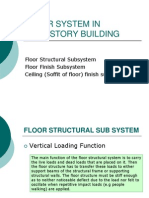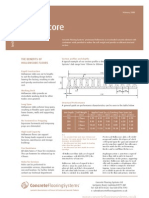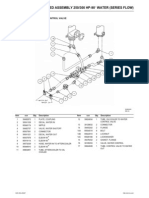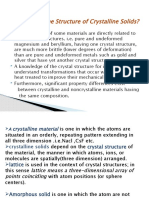0 ratings0% found this document useful (0 votes)
122 viewsStaircase Design
The document provides details on the design of a staircase, including dimensions of steps and spans, assumed loads, and calculations of reactions and bending moments. The maximum bending moment of 16.796 kNm occurs at a point 1.916m from the start of the staircase. With a required effective depth of 150mm, 12 steel reinforcement bars spaced at 150mm centers are sufficient. The span to depth ratio of 25.547 is less than the allowable ratio of 47.096, confirming the design is safe.
Uploaded by
Drafters EngineeringCopyright
© © All Rights Reserved
Available Formats
Download as PDF, TXT or read online on Scribd
0 ratings0% found this document useful (0 votes)
122 viewsStaircase Design
The document provides details on the design of a staircase, including dimensions of steps and spans, assumed loads, and calculations of reactions and bending moments. The maximum bending moment of 16.796 kNm occurs at a point 1.916m from the start of the staircase. With a required effective depth of 150mm, 12 steel reinforcement bars spaced at 150mm centers are sufficient. The span to depth ratio of 25.547 is less than the allowable ratio of 47.096, confirming the design is safe.
Uploaded by
Drafters EngineeringCopyright
© © All Rights Reserved
Available Formats
Download as PDF, TXT or read online on Scribd
You are on page 1/ 4
Staircase Design
Rise of the Step (Rise) 177.800 mm
Tread of the Step (Tread) 228.600 mm
Width of the Step (Width) 0.900 m
Span Length (L1) 1.066 m
Span Length (L2) 1.700 m
Span Length (L3) 1.066 m
Live Load (Lload) 2.000 kN/m2
Railing Load (Raiload) 0.100 kN/m
Finishes Load (Finload) 1.000 kN/m2
Effective Cover 15 mm
Grade of Concrete (M) 20
Grade of Steel (Fe) 415
Detailed Design of Stairs
Assuming the waist slab thickness approximately as 35-40 mm for every metre
longitudinal span.
Waist Slab thickness = (Wst) = (L1+L2+L3)x40 = 153.28 mm
Dead weight of Waist Slab on inclined area (Dlws) = Wst x 0.025
Dlws = 153.28 x 0.025 = 3.832 kN/m2
Dead weight of Waist slab on Horizontal area (Dlwsh) =
Dlws x SQRT(Rise2 + Tread2)/Tread =
3.832x SQRT(177.8^2 +228.6^2)/(228.6) = 4.855 kN/m2
Dead Weight of Steps (Dwsteps) = 0.5 x Rise x Conc Density =
Dwsteps = 0.5 x 177.8 x 25 / 1000 = 2.223 kN/m2
Live Load on the Stair Case (as per IS 875) = 2.000 kN/m2
Finishes Load on the Stair Case (if any) (Fin. Load = 1.000 kN/m2
Loading on Spans L1 and or L3 per metre run (Landing Portion) :
Wl1 = Wl3 = (Dlws + Lload + Finload) = (3.832 + 2 + 1) = 6.832 kN/m
Loading on Span L2 per metre run (Flight Portion)
Wl2 = ((Dlwsh+Dwsteps+Lload+Finload)xwidth + Raiload)/width
Wl2 = ((4.855 + 2.223 + 2 + 1) x 0.9 + 0.1) /0.9 = 10.189 kN/m
Loading Details on Stairs:
6.832 10.189 6.832
A L1 = 1.066 L2 = 1.7 L3 = 1.066 B
Ra 15.944 15.943 Rb
Reactions Ra and Rb
Taking moments of all forces about B
Ra x 3.832 =6.832x1.066x(1.066+1.7+1.066x0.5) + 10.189x1.7(1.066+ 0.5x1.7) +6.832x1.066x0.5x1.066=
Ra x 4.8 = 61.0957 kN
Reaction at the support A = 15.944 kN
Rb = (6.832x1.066 + 10.189x1.7 + 6.832x1.066) - 15.944 = = 15.943 kN
Maximum BM Occurs at the point 'x' where SF is Zero or Changes its sign.
Point of Maximum Moment = 1.916 m
Max BM: 15.944 x 1.916 - 6.832 x 1.066 x (1.916-0.5x1.066) - 10.189 x 0.5 x (1.916 - 1.066)^2
= 16.796 kNm
Factored BM = 1.5 x 16.796 = 25.194 kNm
Required Effective Depth from Bending Point of View:
2
Mu limit = 0.138 fck bd
d (reqd) = Sqrt((Factored BM/(0.138 x fck) = Sqrt((25.194 x 1e+03) /(0.138x 20))
d (reqd) = 95.542 mm However Provide an Effective depth of 150 mm
Provide an overall depth of 170 mm
2
Factor Mu/bd = 25.1941e+03/150^2 = 1.12
Required percentage of steel (pt) = 0.333 %
2
Area of Steel Required = 499.5 mm 12# @ 226.226 mm c/c
However provided steel = 12# @ 150 mm c/c %Ast prov = 0.502
2
Ast Provided = 753 mm Modification Factor for Tensile steel = 1.81137
Allowable Span to effective depth = 47.096
Actual Span to effective depth = 25.547 Hence Safe
Provide 8 mm minimum distribution steel @ 0.12% of gross area = 198 mm2
Provide 8# @ 250 mm c/c
x0.5x1.066=
%
You might also like
- Best Practices in Tribal Housing: Case Studies 2013No ratings yetBest Practices in Tribal Housing: Case Studies 201371 pages
- Office Building For Divi'S Lab at Hyderabad: NCC Drg. No.No ratings yetOffice Building For Divi'S Lab at Hyderabad: NCC Drg. No.1 page
- Study On Interaction Between Rocking Wall System and Surrounding Structure - ACI2016 - Spring - AndyLiuNo ratings yetStudy On Interaction Between Rocking Wall System and Surrounding Structure - ACI2016 - Spring - AndyLiu24 pages
- PHRC Research Report Structural Design of CLT HomeNo ratings yetPHRC Research Report Structural Design of CLT Home53 pages
- Cellular Light Weight Concrete Using Glass FiberNo ratings yetCellular Light Weight Concrete Using Glass Fiber5 pages
- A23.3-04 Precast Corbel Design Spreadsheet Jan 2008: (2/3 Avf + An)No ratings yetA23.3-04 Precast Corbel Design Spreadsheet Jan 2008: (2/3 Avf + An)3 pages
- Elastic Modulus and Strength of ConcreteNo ratings yetElastic Modulus and Strength of Concrete24 pages
- Comparative Seismic Analysis Study of G+ 20 Story Building With Flat Slab and Conventional Slab Using ETABSNo ratings yetComparative Seismic Analysis Study of G+ 20 Story Building With Flat Slab and Conventional Slab Using ETABS9 pages
- Volume Change Response of Precast Concrete BuildingsNo ratings yetVolume Change Response of Precast Concrete Buildings20 pages
- 2501 Structural Challenges of Twisting TowersNo ratings yet2501 Structural Challenges of Twisting Towers8 pages
- Timber Frame Cavity Wall: Colm Flynn 2013No ratings yetTimber Frame Cavity Wall: Colm Flynn 20131 page
- Planning, Analyzing and Designing of Staff Quaters Building by Using STAAD ProNo ratings yetPlanning, Analyzing and Designing of Staff Quaters Building by Using STAAD Pro12 pages
- Structure Details FOR Foundation: Practical Architectural Training-Fun Begins (For Interns and Freshers)100% (1)Structure Details FOR Foundation: Practical Architectural Training-Fun Begins (For Interns and Freshers)37 pages
- Design of One Way Slab-Basic Theory and Procedures-Dr. Latifee-16-Dec-2015v1No ratings yetDesign of One Way Slab-Basic Theory and Procedures-Dr. Latifee-16-Dec-2015v118 pages
- Unit Iii - Selected Topics: Reference Details: Design of RC Elements, Mr. N - Krishnaraju Date of DeliveranceNo ratings yetUnit Iii - Selected Topics: Reference Details: Design of RC Elements, Mr. N - Krishnaraju Date of Deliverance43 pages
- 2018-Shear Wall Analysis and Design Optimization in Case of High Rise Buildings100% (1)2018-Shear Wall Analysis and Design Optimization in Case of High Rise Buildings10 pages
- Anchor Systems.: Hilti. Outperform. OutlastNo ratings yetAnchor Systems.: Hilti. Outperform. Outlast49 pages
- What Materials Do Architects Use: A Guide to Contemporary Architects' Preferred Building MaterialsFrom EverandWhat Materials Do Architects Use: A Guide to Contemporary Architects' Preferred Building MaterialsNo ratings yet
- Study On Pre-Stressed Concrete Grain Silo Based On Non-Cohesive PropertiesNo ratings yetStudy On Pre-Stressed Concrete Grain Silo Based On Non-Cohesive Properties5 pages
- toaz.info-list-of-construction-prices-for-electrical-works-philippines-philcon-prices-pr_aa74796daad0a6ffda9d2121c52a9d22No ratings yettoaz.info-list-of-construction-prices-for-electrical-works-philippines-philcon-prices-pr_aa74796daad0a6ffda9d2121c52a9d224 pages
- ENGINEERING DESIGN GUIDELINE-Relief Valves - Rev 02 PDFNo ratings yetENGINEERING DESIGN GUIDELINE-Relief Valves - Rev 02 PDF30 pages
- How Thick Is Gold Finger PCB Plating and Its CostNo ratings yetHow Thick Is Gold Finger PCB Plating and Its Cost15 pages
- Gledhill Torrent Re Solar Installation GuideNo ratings yetGledhill Torrent Re Solar Installation Guide16 pages
- Biosafety Level 3 (BSL-3) Laboratory Design Standards: January 2020100% (1)Biosafety Level 3 (BSL-3) Laboratory Design Standards: January 202071 pages
- State of The Art and Future of The Blast FurnaceNo ratings yetState of The Art and Future of The Blast Furnace16 pages
- Optional Strain Rate Forms For The Johnson CookNo ratings yetOptional Strain Rate Forms For The Johnson Cook17 pages
- Suppression of Surface Hot Shortness Due To CuNo ratings yetSuppression of Surface Hot Shortness Due To Cu9 pages
- Service Guide-Trampas Cubeta Armstrong-Manual Rapracion, Instalacion, Deteccion de FallasNo ratings yetService Guide-Trampas Cubeta Armstrong-Manual Rapracion, Instalacion, Deteccion de Fallas36 pages
- Ultimate Strength Design (Usd) - Analysis: (2010/2015 NSCP)No ratings yetUltimate Strength Design (Usd) - Analysis: (2010/2015 NSCP)9 pages
- Instruction Manual: Magnetic Flowmeters 10DS3111 Design Level E Sizes 1 Through 12 InchesNo ratings yetInstruction Manual: Magnetic Flowmeters 10DS3111 Design Level E Sizes 1 Through 12 Inches57 pages
- Computational Fluid Dynamics (CFD) Blog - LEAP Australia & New Zealand - Turbulence Part 3 - Selection of Wall Functions and Y - To Best Capture The Turbulent Boundary LayerNo ratings yetComputational Fluid Dynamics (CFD) Blog - LEAP Australia & New Zealand - Turbulence Part 3 - Selection of Wall Functions and Y - To Best Capture The Turbulent Boundary Layer7 pages
- Best Practices in Tribal Housing: Case Studies 2013Best Practices in Tribal Housing: Case Studies 2013
- Office Building For Divi'S Lab at Hyderabad: NCC Drg. No.Office Building For Divi'S Lab at Hyderabad: NCC Drg. No.
- Study On Interaction Between Rocking Wall System and Surrounding Structure - ACI2016 - Spring - AndyLiuStudy On Interaction Between Rocking Wall System and Surrounding Structure - ACI2016 - Spring - AndyLiu
- PHRC Research Report Structural Design of CLT HomePHRC Research Report Structural Design of CLT Home
- A23.3-04 Precast Corbel Design Spreadsheet Jan 2008: (2/3 Avf + An)A23.3-04 Precast Corbel Design Spreadsheet Jan 2008: (2/3 Avf + An)
- Comparative Seismic Analysis Study of G+ 20 Story Building With Flat Slab and Conventional Slab Using ETABSComparative Seismic Analysis Study of G+ 20 Story Building With Flat Slab and Conventional Slab Using ETABS
- Volume Change Response of Precast Concrete BuildingsVolume Change Response of Precast Concrete Buildings
- Planning, Analyzing and Designing of Staff Quaters Building by Using STAAD ProPlanning, Analyzing and Designing of Staff Quaters Building by Using STAAD Pro
- Structure Details FOR Foundation: Practical Architectural Training-Fun Begins (For Interns and Freshers)Structure Details FOR Foundation: Practical Architectural Training-Fun Begins (For Interns and Freshers)
- Design of One Way Slab-Basic Theory and Procedures-Dr. Latifee-16-Dec-2015v1Design of One Way Slab-Basic Theory and Procedures-Dr. Latifee-16-Dec-2015v1
- Unit Iii - Selected Topics: Reference Details: Design of RC Elements, Mr. N - Krishnaraju Date of DeliveranceUnit Iii - Selected Topics: Reference Details: Design of RC Elements, Mr. N - Krishnaraju Date of Deliverance
- 2018-Shear Wall Analysis and Design Optimization in Case of High Rise Buildings2018-Shear Wall Analysis and Design Optimization in Case of High Rise Buildings
- What Materials Do Architects Use: A Guide to Contemporary Architects' Preferred Building MaterialsFrom EverandWhat Materials Do Architects Use: A Guide to Contemporary Architects' Preferred Building Materials
- Study On Pre-Stressed Concrete Grain Silo Based On Non-Cohesive PropertiesStudy On Pre-Stressed Concrete Grain Silo Based On Non-Cohesive Properties
- toaz.info-list-of-construction-prices-for-electrical-works-philippines-philcon-prices-pr_aa74796daad0a6ffda9d2121c52a9d22toaz.info-list-of-construction-prices-for-electrical-works-philippines-philcon-prices-pr_aa74796daad0a6ffda9d2121c52a9d22
- ENGINEERING DESIGN GUIDELINE-Relief Valves - Rev 02 PDFENGINEERING DESIGN GUIDELINE-Relief Valves - Rev 02 PDF
- Biosafety Level 3 (BSL-3) Laboratory Design Standards: January 2020Biosafety Level 3 (BSL-3) Laboratory Design Standards: January 2020
- Service Guide-Trampas Cubeta Armstrong-Manual Rapracion, Instalacion, Deteccion de FallasService Guide-Trampas Cubeta Armstrong-Manual Rapracion, Instalacion, Deteccion de Fallas
- Ultimate Strength Design (Usd) - Analysis: (2010/2015 NSCP)Ultimate Strength Design (Usd) - Analysis: (2010/2015 NSCP)
- Instruction Manual: Magnetic Flowmeters 10DS3111 Design Level E Sizes 1 Through 12 InchesInstruction Manual: Magnetic Flowmeters 10DS3111 Design Level E Sizes 1 Through 12 Inches
- Computational Fluid Dynamics (CFD) Blog - LEAP Australia & New Zealand - Turbulence Part 3 - Selection of Wall Functions and Y - To Best Capture The Turbulent Boundary LayerComputational Fluid Dynamics (CFD) Blog - LEAP Australia & New Zealand - Turbulence Part 3 - Selection of Wall Functions and Y - To Best Capture The Turbulent Boundary Layer

























































































